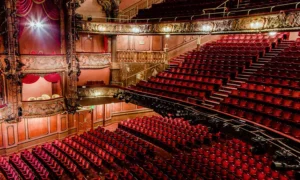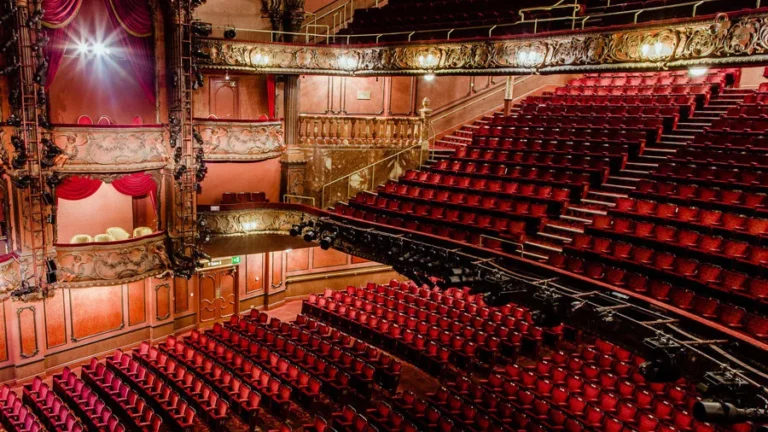
The Lyceum Theatre is a West End theatre located in the City of Westminster, on Wellington Street, just off the Strand in central London. It has a seating capacity of 2,100. The origins of the theatre date to 1765. Managed by Samuel Arnold, from 1794 to 1809 the building hosted a variety of entertainments including a circus produced by Philip Astley, a chapel, and the first London exhibition of waxworks by Madame Tussauds. From 1816 to 1830, it served as The English Opera House. After a fire, the house was rebuilt and reopened on 14 July 1834 to a design by Samuel Beazley. The building is unique in that it has a balcony overhanging the dress circle. It was built by the partnership of Peto & Grissell. The theatre then played opera, adaptations of Charles Dickens novels and James Planché’s “fairy extravaganzas”, among other works.
From 1871 to 1902, Henry Irving appeared at the theatre, especially in Shakespeare productions, usually starring opposite Ellen Terry. In 1904 the theatre was almost completely rebuilt and richly ornamented in Rococo style by Bertie Crewe, but it retained Beazley’s façade and grand portico. It played mostly melodrama over the ensuing decades. The building closed in 1939 and was set to be demolished, but it was saved and converted into a Mecca Ballroom in 1951, styled the Lyceum Ballroom, where many well-known bands played. The Lyceum was closed in 1986 but restored to theatrical use in 1996 by Holohan Architects. Since 1999, the theatre has hosted The Lion King.
History
Early years
The first Lyceum Theatre was housed in a building erected in 1765 on a site adjacent to the present theatre, with its entrance on The Strand, by the architect James Paine for the exhibitions of The Society of Artists. The Society of Artists was not a success, and the building was then leased out for dances and other entertainments, including musical entertainments by Charles Dibdin. Famed actor David Garrick also performed there. In 1794, the composer Samuel Arnold Sr rebuilt the interior of the building, making it into a proper theatre, but through the opposition of the existing patent theatres, he was not granted a patent. Therefore, he leased it to other entertainments again, including Philip Astley, who brought his circus there when his amphitheatre was burned down at Westminster. It was also used as a chapel, a concert room, and for the first London exhibition of waxworks displayed by Madame Tussauds in 1802.
The theatre finally became a licensed house in 1809, and until 1812 it was used for dramatic performances by the Drury Lane Company after the burning of their own theatre, until the erection of the new edifice. It staged one of the earliest tableaux vivants, as part of William Dimond’s The Peasant Boy in 1811. In 1816, Samuel Arnold rebuilt the house to a design by Beazley and opened it as The English Opera House, but it was destroyed by fire in 1830. The house was famous for hosting the London première of Mozart’s opera Così fan tutte (9 May 1811) and as the first theatre in Britain to have its stage lit by gas (6 August 1817). During this period, the “Sublime Society of Beef Steaks”, which had been founded in 1735 by theatre manager Henry Rich, had its home at the theatre for over 50 years until 1867. The members, who never exceeded twenty-four in number, met every Saturday night to eat beefsteaks and drink port wine.
The Lyceum was later managed by Madame Lucia Elizabeth Vestris and Charles James Mathews from 1847–55, who produced James Planché’s ” extravaganzas” featuring spectacular stage effects. Their first big success was John Maddison Morton’s Box and Cox. Tom Taylor’s adaptation of A Tale of Two Cities, with Dickens himself as consultant, played in 1860, shortly after end of its serialisation and volume publication. Charles Fechter, who managed the theatre from 1863–67 also favored spectacular productions. In 1866, Dion Boucicault’s The Long Strike (his adaptation of Elizabeth Gaskell’s Manchester novels Mary Barton and Lizzie Leigh) was produced here. Ethel Lavenu, the mother and grandmother of actors Tyrone Power Sr. and Tyrone Power performed in a number pieces at the theatre in the 1860s. W. S. Gilbert produced three plays here. In 1863, his first professional play, Uncle Baby, premièred. In 1867, he presented his Christmas pantomime, called Harlequin Cock Robin and Jenny Wren, and in 1884, he produced the drama Comedy and Tragedy.
